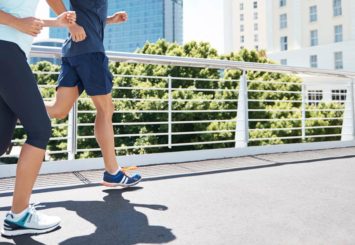Even the most dedicated exercise enthusiast can struggle to stay motivated in winter.
We all know winter can make exercising and healthy eating more challenging, but it shouldn’t be an excuse to go off track. Here are five helpful strategies to stay on track with your exercise and diet routine when it’s cold outside from Claire, student dietitian from @nutritionfoodition on Instagram.
- Identify the barriers that are stopping you from exercising
The sooner you find the barriers that are stopping you from exercising, the sooner you can overcome them with simple strategies. Acknowledging the barriers that may stop you from exercising during the winter can contribute to staying on track with your goals. Some common barriers during the winter include hesitation to exercise in the cold dark mornings, lack of energy throughout the day, struggling to find motivation to get out of bed in the mornings or simply not making the time to prioritise exercise.
- Use strategies to overcome your barriers
There will always be strategies you can implement to overcome winter barriers relating to exercising and healthy eating. Why not try turning the light on as soon as you wake up, organising your workout gear the night before to avoid any unnecessary decision making in the morning or changing your morning exercise routine to the afternoon when it’s a little bit warmer. When it comes to healthy eating habits, make sure to prioritise nutritious, whole food meal options throughout the day to sustain energy and hunger levels. Most importantly, studies have found by identifying and personalising goals can more likely lead to feelings of accomplishment and high physical self-worth, rather than exercise to avoid feelings of guilt1. Therefore, personalising your goals to focus around your barriers is an effective step for a successful and sustainable lifestyle!
- Adapt your routine to suits your winter goals
There is no such thing as an ‘optimal time’ to exercise, so make sure to create your own routine to fit in with your daily schedule to achieve your goals. Exercising outdoors has many benefits such as preventing vitamin D deficiency, having greater feelings of enjoyment and satisfaction, as well as evidence towards being more likely to intend to continue exercising in the future compared to indoor activities2. However, it proves to be more difficult to exercise outdoors as often in winter, so try to create your own strategies to ensure you can support your body by moving and consuming lots of nutrients throughout the season. Making the time to exercise is so important and may require doing a shorter high-intensity session on a busy day, an inside workout on a cold or rainy morning, or separating an exercise session into two 15-minute periods to do in the morning and afternoon.
- Before looking to energy-dense processed meals, prioritise making warm comforting nutritious meals.
Especially for this time of the year, it’s hard to enjoy a cold meal. Hearty soups are a delicious comforting meal idea during the winter. Our Formulite Hearty Lentil Soup makes a perfect lunch or dinner idea and is packed full of fibre and protein to keep you feeling full throughout the day. Lentils are high in nutrients, protein and fibre, and are a great source of slow energy release that contribute to sustained energy throughout the day and can avoid spikes that may make you tired after eating. Fibre is especially important and may contribute to weight loss and weight management.
- Commit to your newly adjusted routine
You’ve done the hard part of adjusting your exercise routine to best suit you, so it’s now time to commit. Enjoy the warmer, comforting meals like soups and other healthy foods, adapt your workout to the weather and your preferences for the time of day to exercise, and most importantly, find a type of exercise that you enjoy! The physical Australian guidelines recommend at least 30 minutes of moderate-intensity physical activity per day. Avoid the stigma that exercise is limited to running or walking. Although these forms are great and very beneficial for your health, just as effective moderate-intensity forms of exercise can include brisk walking, dancing, hiking, swimming, or even incidental exercise like gardening, housework or active engagement in games with your children3.
References:
- Thøgersen-Ntoumani C, Ntoumanis N. The role of self-determined motivation in the understanding of exercise-related behaviours, cognitions and physical self-evaluations. J Sport Sci. 2006 May 01;24(4):393-404.
- Wagner A, Keusch F, Yan T, Clarke P. The impact of weather on summer and winter exercise behaviours. J Sport Health Sci. 2019 Jan;8(1):39-45.
- WHO | What is Moderate-intensity and Vigorous-intensity Physical Activity? [Internet]. 2020 [cited 2020 Jul 21]. Available from https://www.who.int/dietphysicalactivity/physical_activity_intensity/en/



